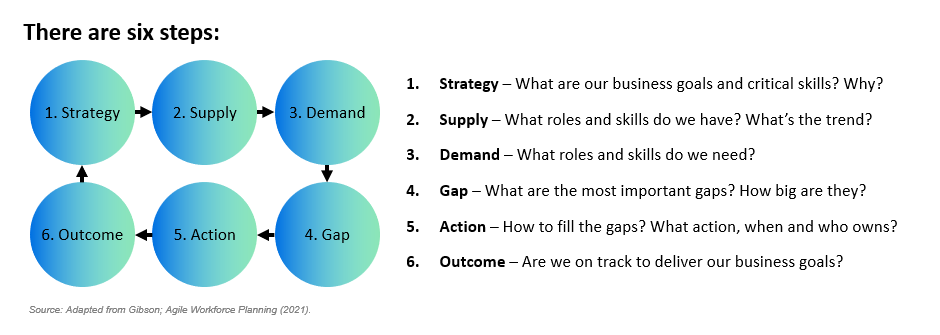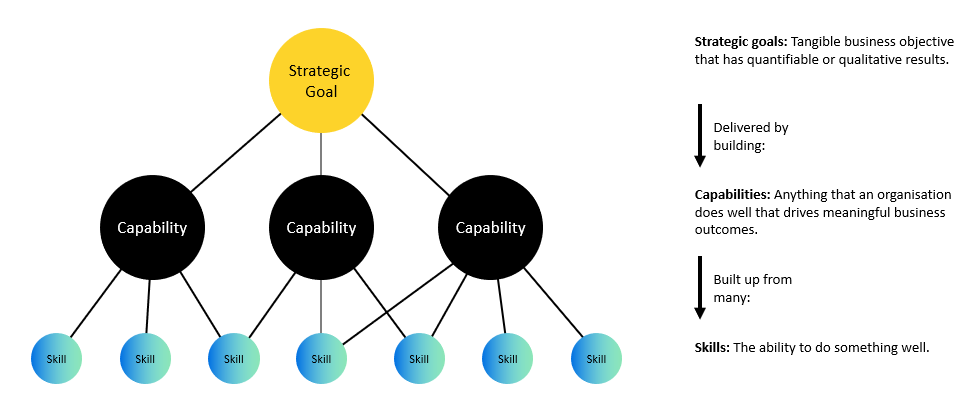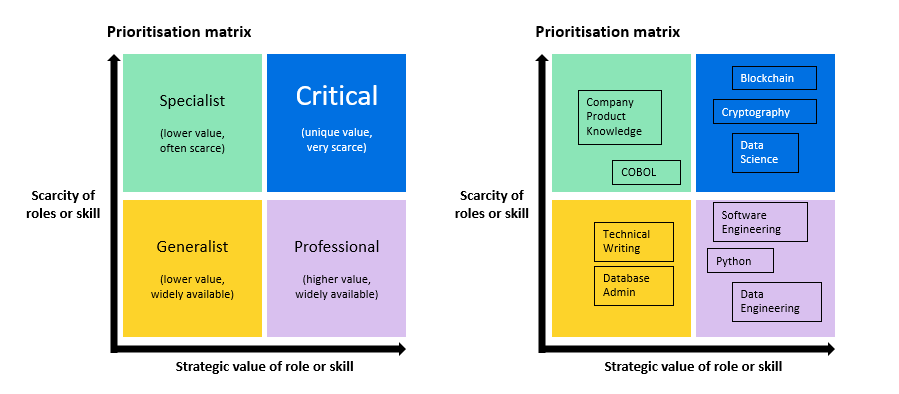Get started with skills-led strategic workforce planning
The trend toward skills-led strategic workforce planning is a real opportunity to drive business, financial and societal value.
Leaders agree, citing investment in digital training, development and upskilling as a top success factor to ensure skills remain future-focused. (2)
But progress is slow.
Only 18% of CEOs reported significant improvement despite intense focus on reskilling and upskilling (1). Clearly, organisations are struggling to put their intentions to work.
Close the gap between intention and outcomes with this guide. We reveal how skills-led strategic workforce planning can be put into practice, building on the latest advances in Talent Intelligence, Skills Management and Data Analytics.
But first, why might you struggle to begin with, and what can you do about it?
What’s the problem?
Well, it probably isn’t your people. They increasingly recognise the ‘future of work’ has arrived: 39% of employees in a global survey thought it likely that their job will be obsolete within five years and 77% are ready to learn new skills or completely retrain. (4)
Embracing this willingness is key. If you’re not planning for it, you risk losing great talent. Because leading organisations in reskilling and upskilling have prioritised engaging employees, building holistic skill-building strategies and defining the skills needed to drive their future growth. (5)
It can be hard to know where to get started, and things can get complex quickly. Plus, whose job is skills anyway? Leaders? HR Directors? Talent? Organisation Design? Learning? Employees? (Hint: it’s a team sport).
What is skills-led workforce planning?
Simply defines strategic workforce planning as identifying and delivering the critical capabilities, roles and skills needed to achieve the business strategy.
It’s all about the outcomes! The goal is not to create a plan, but to create the right workforce to deliver the desired business goals.6
But it’s worth being clear on the questions that skills-led strategic workforce planning exists to answer, such as:
What are our business goals and critical skills?
What are our most important skill gaps?
In which order will we close the gaps?
How will we fill the gaps?
What action can people take?
You might already have established a strategic workforce planning approach with buy-in from key stakeholders. But you can still tweak it to strengthen the skills-lens.
We’re following a slightly adapted Agile Workforce Planning method (6) to guide you.
Rest assured you won’t feel like a fish out of water: at its heart, skills-led strategic workforce planning is still strategic workforce planning. It all happens within the same framework.
What is different? The granularity and specificity of the activity, which is made possible through the lens of skill.
Skills-led strategic workforce planning
Discover the most important concepts and lessons that will help you identify and deliver the critical capabilities, roles and skills needed to achieve your business growth strategy.
We’re going to focus on:
This is not an exhaustive list. But it covers the point-of-difference areas for ‘traditional’ workforce planning. A great starting point to deepen your focus on the right skills.
1. Aligning on language and definitions
We define skill as ‘the ability to do something well’.
It’s helpful to think of skills in the broadest possible way, covering both ‘Transferable’ and ‘Technical’ skills:
Transferable: Foundational skills commonly shared across roles such as problem-solving or communication.
Technical: Specialised skills which require specific domain knowledge or technical training, such as financial analysis or cloud architecture.
Also, values, commitments, behaviours and other frameworks might imply skill too – or describe how skills are deployed.
When engaging your leaders to identify critical skills or build a skills taxonomy to guide planning, be clear at the outset what’s included, and importantly, what lives elsewhere. Aligning on your definition of skills will make this easier.
2. Connecting business outcomes, capabilities and skills
What are our business goals and critical skills?
Skills-led strategic workforce planning helps to answer this question because it pinpoints the connection between:
The goal you’re trying to achieve
The organisational capability that goal needs you to perform well
The bundle of skills that make up that capability
You can picture it as a map:
Planning becomes more granular by adding the unit of skill. So, it’s even more important to link those units back up again.
With thousands and thousands of skills (Simply tracks more than 30,000) you can’t feasibly consider them all.
You can avoid the risk of 'analysis paralysis' by linking skills to strategic goals as soon as possible. There are several tools and techniques you can use to translate strategy into skills, including using Simply Navigate as demonstrated in KPMG’s Pathfinder report.
3. Narrowing down what matters most
Skills-led strategic workforce planning is an exercise in focus.
We need to differentiate between what is genuinely critical and what is important to achieve this.
Not all roles and skills need the same level of attention, and there is only so much time and effort available to plan and act.
Focus as far as possible on the main business goal and leave the other skill observations to be addressed separately by the appropriate team or person, at the right time.
An example: focusing on critical skills
Let’s say you have the business goal of launching a new data app in a financial services company. By interviewing business leaders, HR colleagues and managers as well as analysing external benchmarking, you might easily identify a list of 100 skills, from company product knowledge to technologies such as blockchain. To identify what is critical, ask if the skill:
Supports a critical capability?
Provides current or future competitive advantage?
Drives execution of the business strategy?
Generates a meaningful return on investment?
Answer yes to two or more questions and the skill is likely to be critical.
As a guide, about 15-20% of your skills will be ‘critical’ (7) but this figure is designed to encourage prioritisation, rather than act as a hard rule.
Important: just because something isn’t critical doesn’t mean you shouldn’t act on it, such as roles and skills that fall into the specialist, generalist or professional groups.
Rather, it means you should ensure there is sufficient time, attention and budget given to the critical group. In this example, further attention would be placed on blockchain, cryptography and data science given their relative scarcity and perceived strategic value to the capability and business goal.
Prioritisation matrix
Prioritisation involves a balance of data and judgement. To help navigate this balance, use a combination of internal and external insight to inform prioritisation decisions.
For example, you can use Talent Intelligence to assess the relative scarcity of different roles and skills in the market. Or you can use it to evaluate the priority your competitors are placing on recruiting the same skills.
If you’ve got internal data on the skills across your workforce, that can help inform scarcity too.
4. Take an external lens
The new world of work is more open, with greater flexibility on where, when and how work gets done across most industries and companies. This is driving a need to have a grip on the external context, risks and opportunities this creates.
Talent Intelligence can give you that all-important outside lens, using external data alongside other data sources to drive business decisions.
The use of external data in workforce planning isn’t new, but skills-led workforce planning can benefit from an even greater depth of insight. This is particularly important in the Supply, Demand and Action steps. What was once a Talent Acquisition specialism is becoming more mainstream.
For example, leading companies are using external data points, such as the popularity of different skills in their industry and roles, to challenge their leaders’ beliefs on what skills are most important and whether they’re truly scarce.
The use of competitive benchmarks can also help stimulate leadership engagement.
To illustrate, a Simply Navigate SaaS customer evaluated their expansion into an adjacent industry by using the top roles and skills targeted by established peers to better understand the roles and skills required.
They also learnt about the way in which those SaaS native organisations were developed. This insight led to new critical skill priorities built into their strategy, adjusting hiring plans to target specific companies and targeting skill development in specific critical roles.
Learn more about Simply Navigate’s capabilities as an external lens in KPMG’s Pathfinder report.
5. Adopting a ‘Total Workforce’ approach
A major benefit of skills-led workforce planning? It can use the concepts of capability and skill to cut across defined organisational structures and boundaries.
That’s not to say you don’t need to baseline to join it all back up again. But you should take advantage of the freedom this approach affords to develop creative solutions before constraining your thinking.
As Linda Aiello, Salesforce’s EVP, Employee Success Business Partner, observes:
“The best jobs three years from now probably don’t even exist yet” (5)
The ability to think creatively about how you might acquire skills over time is critical.
In the Action step, the ‘Total Workforce’5 approach would consider current employees, contractors, partners, other employers, alumni, automation and so on.
Being clear on the skills you’re looking for helps you be more specific when considering the best route to acquire the skill. It can also help develop new ways to strengthen diversity, equity, inclusion and belonging. For example, hiring and developing neurodiverse talent who might be ideal candidates when the required skills are the central goal in action planning. (8)
Lead by our customers’ example
Our customers are prioritising development actions first in their action planning. Skills-led strategic workforce planning takes you beyond the constraints of role to consider the skills required.
This makes it much easier to imagine re-deploying, reskilling or upskilling people to fulfil the need. Data on the similarity between roles and skills can help make these opportunities very tangible, even if you haven’t invested in a Talent Marketplace, run a skills claim or completed an inventory activity.
The key takeaway
Skills-led strategic workforce planning is the vehicle to make coordinated decisions around skills.
By focussing on business strategy and values, you can simultaneously be hyper-targeted in your actions while guiding employees to the roles and skills that matter most. Advances in ‘Skills Tech’ – like Simply Navigate – have made this easier to achieve for all organisations.
If you want to learn more about strategic workforce planning, dive into our latest free report, The Winning Skills Advantage.
Get in touch. We’ll show you how Simply makes skills-led workforce planning easy.
References:
1 PwC, Talent Trends 2020
https://www.pwc.com/gx/en/ceo-survey/2020/trends/pwc-talent-trends-2020.pdf
2 KPMG, CEO Outlook 2021
https://home.kpmg/xx/en/home/insights/2021/03/ceo-outlook-pulse.html
3 MyHRFuture, Building an effective skills-based workforce planning capability
https://www.myhrfuture.com/blog/2021/6/10/building-an-effective-skill-based-workforce-planning-capability
4 PwC, Upskilling Hopes and Fears 2021
https://www.pwc.com/gx/en/issues/upskilling/hopes-and-fears.html
5 KPMG, The future of HR: Lessons from the Pathfinders
https://home.kpmg/xx/en/home/insights/2021/09/the-future-of-hr-lessons-from-the-pathfinders.html
6 Adam Gibson; Agile Workforce Planning (2021).
7 Becker, Huselid and Beatty; The Differentiated Workforce: Transforming Talent into Strategic Impact (2009)
8 BBC, Does your company nurture neurodiverse talent?
https://www.bbc.co.uk/news/uk-51014028
9 Josh Bersin, Eight Learnings About Jobs, Skills, And Org Design. And The Apple Genius Bar
https://joshbersin.com/2021/08/eight-learnings-about-jobs-skills-and-org-design-and-the-apple-genius-bar/
10 Adam Gibson, Identifying Your Critical Workforce
http://agileworkforceplanning.com/combatting-capability-decay-copy/
11 Workforce planning has changed: Why you now need to plan skills not roles https://www.simplygetresults.com/insights/workforce-planning-for-critical-skills




